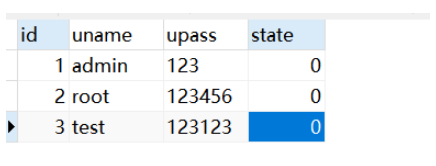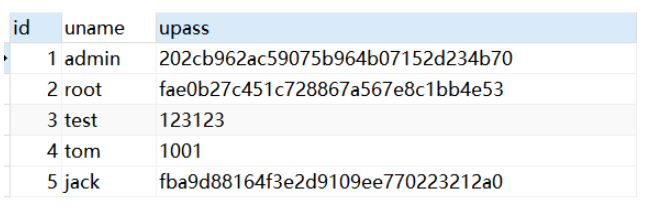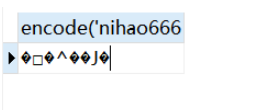How to use MD5 encryption in MySQL
What is MD5?
MD5 Message-Digest Agorithm (English: MD5 Message-Digest Agorithm), a widely used cryptographic hash function that can produce a 128-bit (16-byte) hash value (hash value) , used to ensure complete and consistent information transmission. MD5 was designed by American cryptographer Ronald LinnRivest and made public in 1992 to replace the MD4 algorithm. The program of this algorithm is specified in the RFC1321 standard. After 1996, it was confirmed that the algorithm has weaknesses and can be cracked. For data that requires high security, experts generally recommend using other algorithms, such as SHA-2. In 2004, it was confirmed that the MD5 algorithm cannot prevent collisions, so Not suitable for security authentication, such as SSL public key authentication or digital signatures.
MD5 First Experience

Prepare a simple user table in mysql for case operations.
Next, test various sql statements:
Normal insertion statement (password plain text):
-- 普通新增语句(明文密码) insert into user(uname,upass) values ('tom','1001');
Encrypt when inserting information**: **
-- 插入时使用MD5 算法加密 insert into user(uname,upass) values ('jack',MD5('1002'));
Query and view results:

Modify: Use the MD5 algorithm to modify the password of the account admin.
-- 将原密码换为MD5加密后的密码 update user set upass=MD5(upass) where id =1; -- 将原密码123456修改为 MD5加密后的密码(666) update user set upass=MD5('666') where id =2;
Result:

Encrypt all passwords:
-- 加密全部密码 update user set upass=MD5(upass)

Conditional query for verification:
-- 根据账号密码 查询对应账号信息 select * from user where uname='admin' and upass=MD5('123')

-- 测试 将密码修改为666 的账号信息 select * from user where uname='root' and upass=MD5('666')

The above is a simple encryption of some information in the mysql database through the MD5 algorithm. The specific knowledge needs to be sorted out.
Other methods in MySQL
(1) PASSWORD() function:
-- password() 函数加密 update userinfo set password =password('333') where id=6 -- 查询验证 select * from userinfo where password=password('333')
password(str) calculates and returns the encrypted password string from the original plaintext password str, When the parameter is null, null is returned. Password encryption is one-way and irreversible.
(2) ENCODE() function
ENCODE(str, pass_str) function is used to encode plain text strings and return binary strings after encoding.
Use pswd_str as password, encrypt str.
str: It is used to specify the plain text to be encoded
pass_str: It is used to specify the password string to plain text characters The string is encoded.
-- 字符串 select encode('hello','nice')

-- 字符串和数字 select encode('nihao666','nice')

(3) DECODE(crypt_str,pass_str)
Use pswd_str as the password, Decrypt the encrypted string crypt_str, crypt_str is the string returned by encode().
select DECODE('nihao666','nice')

-- 使用decode函数解密encode加密的字符串 select DECODE(ENCODE('nihao666','nice'),'nice');

The above is the detailed content of How to use MD5 encryption in MySQL. For more information, please follow other related articles on the PHP Chinese website!

Hot AI Tools

Undresser.AI Undress
AI-powered app for creating realistic nude photos

AI Clothes Remover
Online AI tool for removing clothes from photos.

Undress AI Tool
Undress images for free

Clothoff.io
AI clothes remover

Video Face Swap
Swap faces in any video effortlessly with our completely free AI face swap tool!

Hot Article

Hot Tools

Notepad++7.3.1
Easy-to-use and free code editor

SublimeText3 Chinese version
Chinese version, very easy to use

Zend Studio 13.0.1
Powerful PHP integrated development environment

Dreamweaver CS6
Visual web development tools

SublimeText3 Mac version
God-level code editing software (SublimeText3)

Hot Topics
 MySQL's Role: Databases in Web Applications
Apr 17, 2025 am 12:23 AM
MySQL's Role: Databases in Web Applications
Apr 17, 2025 am 12:23 AM
The main role of MySQL in web applications is to store and manage data. 1.MySQL efficiently processes user information, product catalogs, transaction records and other data. 2. Through SQL query, developers can extract information from the database to generate dynamic content. 3.MySQL works based on the client-server model to ensure acceptable query speed.
 How to start mysql by docker
Apr 15, 2025 pm 12:09 PM
How to start mysql by docker
Apr 15, 2025 pm 12:09 PM
The process of starting MySQL in Docker consists of the following steps: Pull the MySQL image to create and start the container, set the root user password, and map the port verification connection Create the database and the user grants all permissions to the database
 Laravel Introduction Example
Apr 18, 2025 pm 12:45 PM
Laravel Introduction Example
Apr 18, 2025 pm 12:45 PM
Laravel is a PHP framework for easy building of web applications. It provides a range of powerful features including: Installation: Install the Laravel CLI globally with Composer and create applications in the project directory. Routing: Define the relationship between the URL and the handler in routes/web.php. View: Create a view in resources/views to render the application's interface. Database Integration: Provides out-of-the-box integration with databases such as MySQL and uses migration to create and modify tables. Model and Controller: The model represents the database entity and the controller processes HTTP requests.
 Solve database connection problem: a practical case of using minii/db library
Apr 18, 2025 am 07:09 AM
Solve database connection problem: a practical case of using minii/db library
Apr 18, 2025 am 07:09 AM
I encountered a tricky problem when developing a small application: the need to quickly integrate a lightweight database operation library. After trying multiple libraries, I found that they either have too much functionality or are not very compatible. Eventually, I found minii/db, a simplified version based on Yii2 that solved my problem perfectly.
 How to install mysql in centos7
Apr 14, 2025 pm 08:30 PM
How to install mysql in centos7
Apr 14, 2025 pm 08:30 PM
The key to installing MySQL elegantly is to add the official MySQL repository. The specific steps are as follows: Download the MySQL official GPG key to prevent phishing attacks. Add MySQL repository file: rpm -Uvh https://dev.mysql.com/get/mysql80-community-release-el7-3.noarch.rpm Update yum repository cache: yum update installation MySQL: yum install mysql-server startup MySQL service: systemctl start mysqld set up booting
 Centos install mysql
Apr 14, 2025 pm 08:09 PM
Centos install mysql
Apr 14, 2025 pm 08:09 PM
Installing MySQL on CentOS involves the following steps: Adding the appropriate MySQL yum source. Execute the yum install mysql-server command to install the MySQL server. Use the mysql_secure_installation command to make security settings, such as setting the root user password. Customize the MySQL configuration file as needed. Tune MySQL parameters and optimize databases for performance.
 Laravel framework installation method
Apr 18, 2025 pm 12:54 PM
Laravel framework installation method
Apr 18, 2025 pm 12:54 PM
Article summary: This article provides detailed step-by-step instructions to guide readers on how to easily install the Laravel framework. Laravel is a powerful PHP framework that speeds up the development process of web applications. This tutorial covers the installation process from system requirements to configuring databases and setting up routing. By following these steps, readers can quickly and efficiently lay a solid foundation for their Laravel project.
 MySQL and phpMyAdmin: Core Features and Functions
Apr 22, 2025 am 12:12 AM
MySQL and phpMyAdmin: Core Features and Functions
Apr 22, 2025 am 12:12 AM
MySQL and phpMyAdmin are powerful database management tools. 1) MySQL is used to create databases and tables, and to execute DML and SQL queries. 2) phpMyAdmin provides an intuitive interface for database management, table structure management, data operations and user permission management.






